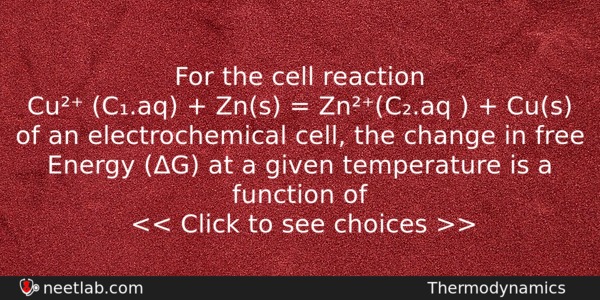| ⇦ | 
| ⇨ |
For the cell reaction
Cu²⁺ (C₁.aq) + Zn(s) = Zn²⁺(C₂.aq ) + Cu(s)
of an electrochemical cell, the change in free Energy (ΔG) at a given temperature is a function of
Options
(a) ln (C₂)
(b) ln (C₂/C₁)
(c) ln (C₁)
(d) ln (C₁ + C₂)
Correct Answer:
ln (C₂/C₁)
Explanation:
No explanation available. Be the first to write the explanation for this question by commenting below.
Related Questions: - In which of the following, the entropy decreases
- A no. of ionic compounds, e.g., AgCl, CaF₂, BaSO₄ are insoluable in water
- In the van der Waals equation, ‘a’ signifies
- The geometry of Ni(CO)₄ and Ni(PPh₃)₂Cl₂ are
- When sodium bicarbonate is heated strongly for calcined in a Kiln, it forms
Topics: Thermodynamics
(179)
Subject: Chemistry
(2512)
Important MCQs Based on Medical Entrance Examinations To Improve Your NEET Score
- In which of the following, the entropy decreases
- A no. of ionic compounds, e.g., AgCl, CaF₂, BaSO₄ are insoluable in water
- In the van der Waals equation, ‘a’ signifies
- The geometry of Ni(CO)₄ and Ni(PPh₃)₂Cl₂ are
- When sodium bicarbonate is heated strongly for calcined in a Kiln, it forms
Topics: Thermodynamics (179)
Subject: Chemistry (2512)
Important MCQs Based on Medical Entrance Examinations To Improve Your NEET Score
18000+ students are using NEETLab to improve their score. What about you?
Solve Previous Year MCQs, Mock Tests, Topicwise Practice Tests, Identify Weak Topics, Formula Flash cards and much more is available in NEETLab Android App to improve your NEET score.
Share this page with your friends

Leave a Reply